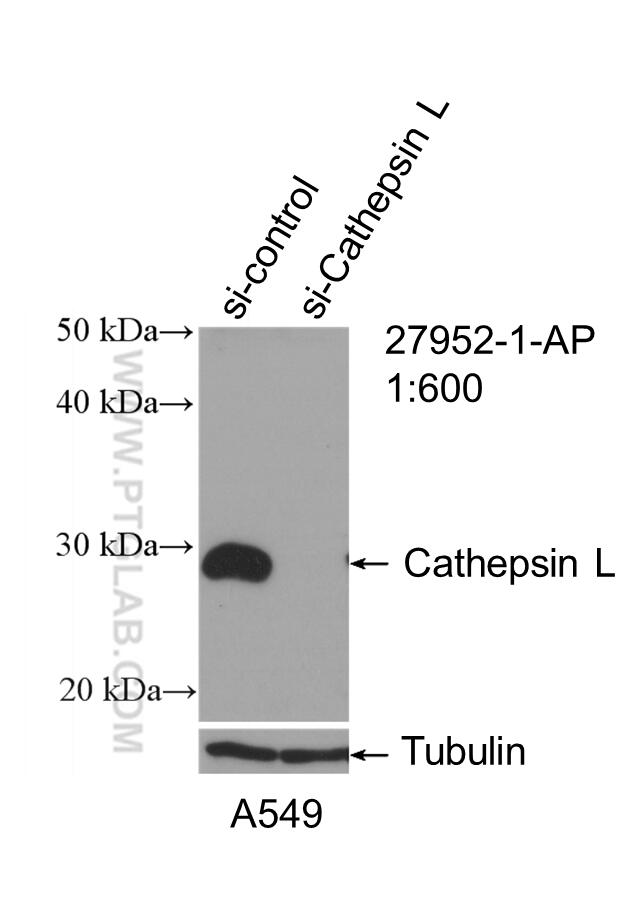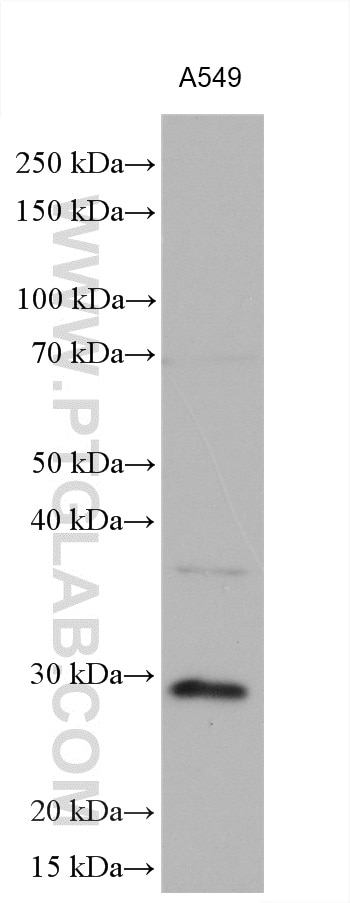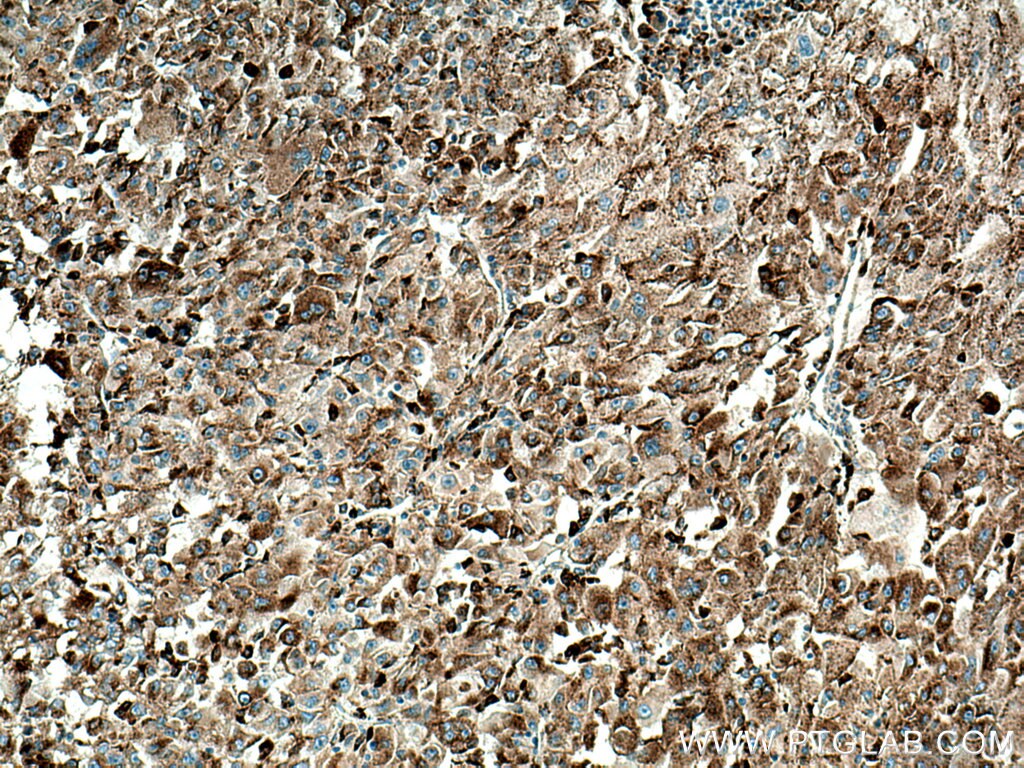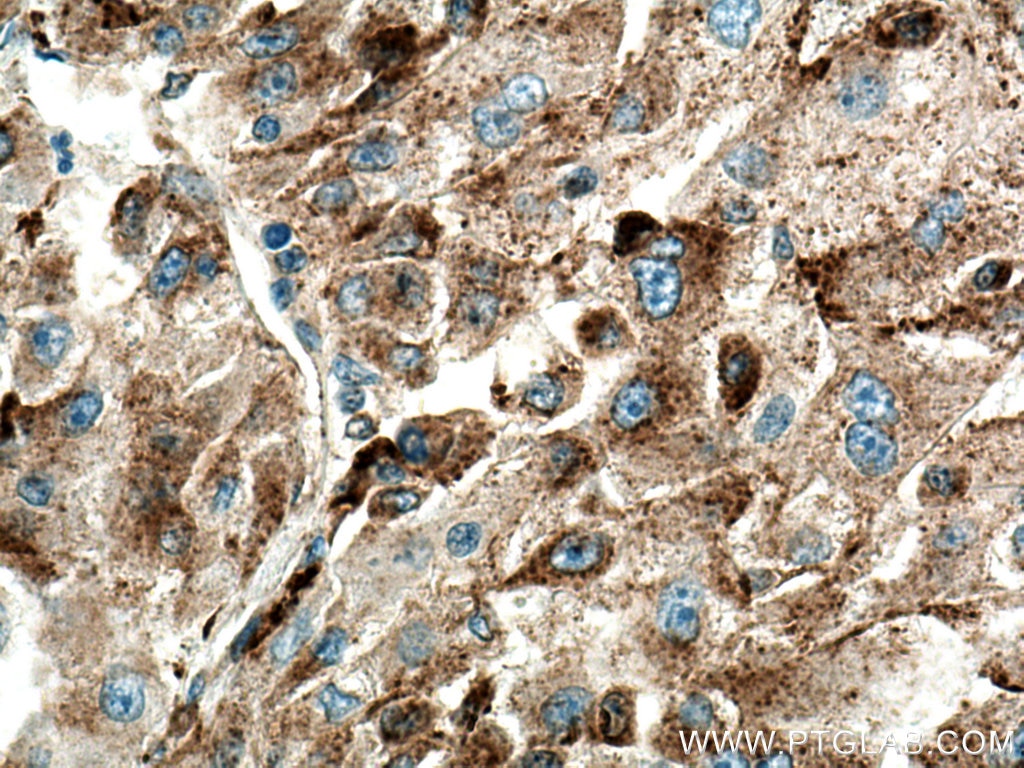Validation Data Gallery
Tested Applications
| Positive WB detected in | A549 cells |
| Positive IHC detected in | human liver cancer tissue Note: suggested antigen retrieval with TE buffer pH 9.0; (*) Alternatively, antigen retrieval may be performed with citrate buffer pH 6.0 |
Recommended dilution
| Application | Dilution |
|---|---|
| Western Blot (WB) | WB : 1:500-1:1000 |
| Immunohistochemistry (IHC) | IHC : 1:50-1:500 |
| It is recommended that this reagent should be titrated in each testing system to obtain optimal results. | |
| Sample-dependent, Check data in validation data gallery. | |
Published Applications
| KD/KO | See 2 publications below |
| WB | See 9 publications below |
| IHC | See 4 publications below |
| IF | See 2 publications below |
Product Information
27952-1-AP targets Cathepsin L in WB, IHC, IF, ELISA applications and shows reactivity with Human, mouse samples.
| Tested Reactivity | Human, mouse |
| Cited Reactivity | human, mouse |
| Host / Isotype | Rabbit / IgG |
| Class | Polyclonal |
| Type | Antibody |
| Immunogen |
CatNo: Ag27813 Product name: Recombinant human Cathepsin L protein Source: e coli.-derived, PGEX-4T Tag: GST Domain: 114-288 aa of BC012612 Sequence: APRSVDWREKGYVTPVKNQGQCGSCWAFSATGALEGQMFRKTGRLISLSEQNLVDCSGPQGNEGCNGGLMDYAFQYVQDNGGLDSEESYPYEATEESCKYNPKYSVANDTGFVDIPKQEKALMKAVATVGPISVAIDAGHESFLFYKEGIYFEPDCSSEDMDHGVLVVGYGFEST 相同性解析による交差性が予測される生物種 |
| Full Name | cathepsin L1 |
| Calculated molecular weight | 38 kDa |
| Observed molecular weight | 36-39 kDa, 29 kDa |
| GenBank accession number | BC012612 |
| Gene Symbol | Cathepsin L |
| Gene ID (NCBI) | 1514 |
| RRID | AB_2881021 |
| Conjugate | Unconjugated |
| Form | |
| Form | Liquid |
| Purification Method | Antigen affinity purification |
| UNIPROT ID | P07711 |
| Storage Buffer | PBS with 0.02% sodium azide and 50% glycerol{{ptg:BufferTemp}}7.3 |
| Storage Conditions | Store at -20°C. Stable for one year after shipment. Aliquoting is unnecessary for -20oC storage. |
Background Information
CTSL1(Cathepsin L1) is also named as CTSL and MEP, belongs to the peptidase C1 family. It is a lysosomal proteinase whose expression is also up-regulated in the skeletal muscle during starvation(PMID:20088826). It plays an intracellular role in normal intestinal epithelial polarization and initiation of neoplasia(PMID:17622569). CTSL1 also improves cardiac function and inhibits cardiac hypertrophy, inflammation, and fibrosis through blocking AKT/GSK3B signaling(PMID:19096818). The full length protein is 38 kDa with a signal peptide, two propeptide and a glycosylation site. It has been detected the 36 kDa, 39 kDa, 29 kDa and 21 kDa in rat gastrocnemius muscle. These forms of cathepsin L could either be attributed to differences in glycosylation or to partial processing of the proenzyme. (PMID:11696001)
Protocols
| Product Specific Protocols | |
|---|---|
| IHC protocol for Cathepsin L antibody 27952-1-AP | Download protocol |
| WB protocol for Cathepsin L antibody 27952-1-AP | Download protocol |
| Standard Protocols | |
|---|---|
| Click here to view our Standard Protocols |
Publications
| Species | Application | Title |
|---|---|---|
Front Pharmacol Nodosin Exerts an Anti-Colorectal Cancer Effect by Inhibiting Proliferation and Triggering Complex Cell Death in Vitro and in Vivo | ||
Acta Pharmacol Sin Salvianolic acid B suppresses hepatic fibrosis by inhibiting ceramide glucosyltransferase in hepatic stellate cells | ||
World J Gastroenterol Macrophage-derived cathepsin L promotes epithelial-mesenchymal transition and M2 polarization in gastric cancer
| ||
Neuron Macrophage-derived CTSS drives the age-dependent disruption of the blood-CSF barrier | ||
Pharmacol Res The molecular receptor NKBB enhances the persistence and anti-hepatocellular carcinoma activity of GPC3 CAR-T cells | ||
J Cell Mol Med CTSL Promotes Autophagy in Laryngeal Cancer Through the IL6-JAK-STAT3 Signalling Pathway
|




